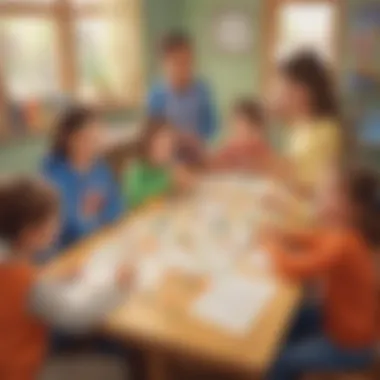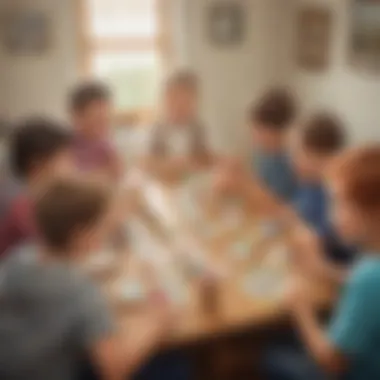Engaging Games to Master Division for Kids


Intro
Understanding division is a fundamental component of mathematics that can seem daunting to young minds. However, engaging in games can provide a vibrant and dynamic way to stimulate interest and enhance comprehension in division. By incorporating play into learning, children not only grasp theoretical concepts but also make practical applications in a memorable way.
In this article, we will explore various creative activities, fun quizzes, and fact-based articles, all aimed at making division approachable and enjoyable for elementary school students. These methods not only support the acquisition of skills but also promote mathematical confidence, essential for their overall educational development.
Creative Activities
Incorporating creative activities into learning can turn a tedious subject like division into an entertaining challenge. These activities allow children to explore math concepts in an interactive and hands-on environment.
Craft Ideas
Crafting offers a tactile way for children to engage with division. Here are some ideas:
- Division Wheel: Colorful wheels divided into sections can visually demonstrate how numbers split.
- Division Beads: Using beads to represent different numbers reinforces the concept as children divide groups physically.
Step-by-Step Guides
To ensure these crafts are easy to replicate, clear instructions are vital. For example:
- To create a Division Wheel, follow these steps:
- Gather a paper plate and divide it into sections using a ruler.
- Label each section with division problems.
- Assist children in rotating the plate to find the answer to various problems.
Educational Value
Creative crafting activities foster multiple educational benefits. They enhance fine motor skills, stimulate creativity, and develop spatial awareness. Furthermore, engaging in crafting helps solidify mental constructs of division, making abstract concepts more tangible.
Fun Quizzes
Quizzes stand as effective tools for reinforcing learning. They offer a method to check understanding in a lively format.
Quiz Topics
Some varied topics could include:
- Basic division facts
- Word problems involving division
- Division related to practical situations, like sharing snacks or toys.
Question Types
A mixture of question types helps maintain interest. For instance:
- Multiple-choice questions to gauge understanding
- Fill-in-the-blank questions to encourage recall
- Story-based problems to enhance critical thinking.
Knowledge Reinforcement
Quizzes help solidify learned principles. They're perfect for knowledge reinforcement, ensuring that concepts of division stick. By applying division through interactive questions, children can better comprehend and enjoy mathematics.
Fact-Based Articles
Informational reading is another powerful tool in the educational journey.
Topics
A diverse range of topics can enrich children's understanding of division, such as:
- Historical context of division methodology
- Applications of division in real-world scenarios.
Engaging Content
Articles aimed at young audiences present information clearly. They turn complex ideas into digestible bits, encouraging curiosity and inquiry.
Preamble to Division
Division forms a core component of arithmetic. It allows individuals to understand how numbers can be grouped or shared. In a classroom setting, introducing students to the concept of division can change their relationship with math. This helps them develop critical thinking skills and become literate in mathematical language.
Understanding Division
Division is, in simple terms, the process of splitting into equal parts. For instance, if a child has 12 apples and wants to distribute them evenly among four friends, understanding division helps them recognize each person will receive three apples. Young learners may naturally possess some grasp of division through practical experiences like sharing snacks or toys. Thus, enabling their understanding of abstract classroom methods can pave the way for broader academic growth.
The process typically involves two primary terms: the divisor (the number of groups) and the dividend (the total being divided). Choosing suitable learning methods can enhance the understanding of these terms. Using visual aids or hands-on activities can drive much better comprehension of division for young minds. Additionally, establishing a robust foundation in division opens doors for advanced mathematics later in education, covering fractions, ratios, and even algebraic concepts.


Relevance of Division in Daily Life
Division is not just an academic concept; it is prevalent in daily life situations. Whether it's a baker scaling a recipe, a parent dividing a bill for a family dinner, or a student calculating practice time shared among friends, division plays an integral role. Here are some examples where division comes into action:
- Splitting costs among friends when dining out.
- Determining quantities in cooking, for instance, adjusting servings for a larger group.
- Analyzing sports statistics to understand performance, such as averages among players.
The practical application of division encourages mastery of the concept from an early age. By recognizing its importance, children start to see math not as a mundane task but as a valuable tool for everyday life. This shift in perception aids not only in their education but also fosters a mind open to learning and problem-solving.
Understanding division equips young learners with essential skills. It is a bridge to advanced mathematics, a practical tool for daily tasks, and an avenue for enhancing critical thinking capabilities.
The Benefits of Game-Based Learning
Game-based learning has emerged as a compelling method for developing math skills, especially in division, among young students. The nature of educational games aligns with the learning needs of children. They not only make the subject fascinating but also foster skill development through enjoyable activities. These benefits help in creating a more comprehensive approach to mathematics that keeps young minds sharpened.
Enhancement of Cognitive Skills
Cognitive skills focus on how students process information, reason, solve problems, and learn. Educational games target these areas effectively. When children engage in computational activities, their memory and retention capabilities soar. They practice division in scenarios designed to be lively and interactive.
Problem-solving and critical thinking are infused naturally in gameplay. Games that challenge players to make quick calculations or strategize their moves directly influence logical thinking. The complexity of unfamiliar division problems, especially within digital formats, can scaffold children’s approaches, making difficult concepts more digestible. Studies show that participants in game-based learning often exhibit smoother transitions into more abstract mathematical contexts.
Promotion of Collaborative Learning
Games offer a unique avenue for collaboration among young learners. When children work together, they build social skills and learn teamwork. In the context of division games, collaboration extends understanding as students share strategies and approaches.
Often, students will discuss their ways of solving division problems with peers. This helps them clarify misunderstandings and deepen their knowledge. One effective strategy is organizing group competitions. These can motivate classmates to tackle division in imaginative ways while learning from one another's insights. Therefore, not only do learners work on numbers, but they also hone interpersonal skills.
Increased Engagement and Motivation
Motivation is a critical component in the learning process. Children are more engaged in classrooms that deliver material through games. The element of competition, timely rewards, and immediate feedback fuels their excitement.
When students are enthused about division, they are less intimidated by the subject. Creativity shines as they dive into games that employ lessons disguised as fun activities. The potential for open exploration steals their attention away from being simply passive learners. Instead, they become active participants managing their learning pace and interest.
Learning environments ripe with interactivity nurture a lasting love for math among elementary students, where division challenges aren't viewed with dread but approached with zeal.
Types of Games for Mastering Division
Understanding division is vital for elementary school children as it lays the groundwork for various mathematical concepts. Games offer a dynamic way for kids to grasp division while enjoying the learning process. Educational games can make this challenging subject more accessible and engaging. When selecting games aimed at practicing division, it is essential to consider the format and structure. The types of games can significantly impact how children absorb and retain their learning.
Among the various categories, digital games, board games, and card games each contribute uniquely to mastering division. These games not only provide a fun environment but also host functions that reinforce division skills deeply.
Digital Games
Digital games have become increasingly popular due to their interactive nature. They generally offer instant feedback which can be valuable for children's understanding. Many digital division games involve fun themes or characters that captivate young minds. These games can help in making complex division problems more understandable.
Some benefits of digital games include:
- Accessibility: Children can play them on various devices such as tablets or computers, making learning more flexible.
- Instant Feedback: Many games feature immediate responses to players’ answers, allowing kids to grasp their strengths and weaknesses quickly.
- Variety of Difficulty Levels: Digital platforms often allow tailoring difficulties for different age groups, engaging kids at their own skill levels.
However, parents should ensure that digital gameplay is balanced with traditional learning. It is key to integrate time spent on screens with other educational methods.
Board Games
Board games also provide kids with a hands-on method for practicing division. These games instill a sense of play that can be lost in textbook approaches. Playing board games can promote group interaction and discussion about different division strategies.
Consider the advantages:
- Social Interaction: Kids can play with friends or family, encouraging teamwork that hones their communication skills.
- Critical Thinking: Board games often require strategic decision-making, fostering analytical skills alongside division practice.
- Physical Engagement: Manipulating physical game pieces can enhance fine motor skills, integrating movement with mental tasks.
Even though they may require more time to set up and play, the bonds formed through these games can create positive associations with learning.
Card Games
Card games present another way to explore division concepts outside formal settings. Simple card games can swiftly turn challenging division problems into fun activities. Using a standard deck of cards can be both inexpensive and resourceful, as many games can be adapted to include division rules.
Key benefits of card games include:
- Flexibility: Cards can easily adjust to different amounts of players, making them ideal for small learning groups or larger classes.
- Variability: Games can be separated into beginner and advanced levels simply by adjusting rules or card distributions.
- Quick Play: Most card games take less time than board games, fitting easily into short breaks or transition times.
When developing an understanding of division, all three game types hold merits. By providing opportunities for practice within enjoyable formats, they both cater to and elevate young learners’ skills and confidence.
Incorporating various games in educational settings can rejuvenate the sometimes dull subject of mathematics, specifically division. Remember, the end goal is not only to teach division but to foster a lasting understanding and appreciation for math.
Digital Games to Practice Division


In the realm of education, digital games stand as a pivotal resource in teaching division concepts. Their interactive nature captivates young learners, turning what can often be viewed as a challenging subject into an engaging experience. Digital games often integrate vibrant visuals, intriguing narratives, and interactive problem-solving scenarios, making the concept of division more accessible to elementary school students. Furthermore, these games effectively blend entertainment with educational content, allowing children to learn division while having fun.
Digital games also offer tangible feedback on performance. Students see their progress reflected as they advance through levels or earn rewards, propelling them to set and achieve new goals. This encourages a growth mindset, as they understand that mastery is reachable, benefiting not only their division skills, but strengthening overall mathematical skills as well.
There are essential considerations for parents and educators using digital games. First, selecting games that align with your educational standards is crucial, ensuring the content meets curriculum guidelines. Furthermore, moderation is important, as too much screen time can counteract the learning experience. Lastly, complementing digital play with hands-on activities and discussions reinforces the skills gained through gameplay, yielding a more rounded educational approach.
Interactive Division Apps
Interactive division apps provide a wide range of resources for practicing division. These apps often include colorful graphics that appeal to children, which makes learning division feel like a game rather than a chore. They can vary from simple math quizzes to complex problem-solving scenarios tailored to dynamic age groups. The gather feedback allows students to see their mistakes, encouraging them to learn from errors instead of becoming discouraged. Popular choices include apps like Prodigy Math and IXL, which gamify the learning process and adapt to the student's level, ensuring a personalized experience.
Exciting features such as achievements and rewards motivate young learners to continue practicing division. The competitive aspects engage children as they strive for better results, fostering a motivated learning environment.
Online Division Challenges
Online division challenges often occur within educational platforms or gamified websites, encouraging students to improve their skills in a competitive yet supportive way. These challenges, often in a format like math tournaments or leaderboards, capture students' interest by introducing a level of competition that pushes them to perform well.
Many engaging sites such as Kahoot! or MathBlaster present users with timed challenges that require quick thinking and immediate recall of division facts. Real-time feedback from these challenges helps learners identify areas needing improvement, allowing them refine their skills dynamically without feeling lost.
Handling Missed Questions
When students encounter tricky questions, having access to hints or explanations can aid their understanding. This approach encourages a problem-solving attitude rather than just finding answers, making the learning process more holistic.
Educational Websites Offering Division Games
Several educational websites offer a framework for practicing division through interactive games. These resources often provide not only games for practicing but also instructional materials and worksheets that reinforce division concepts.
Proficiently designed sites such as ABCya! and Coolmatkids host a diverse array of games that make learning appealing and entertaining. ABCya! carries numerous division-based activities guaranteed to strengthen students' division skills at differing levels of complexity.
In a similar vein, Math is Fun provides educational articles alongside practical games. This creates a rich environment for students to explore division on a deeper level, increasing both understanding and retention of concepts associated with division.
In summary, digital games formatted specifically for division learning offer compelling routes for young minds to engage with mathematics. The effectiveness of learning is further heightened when paired with interactive apps, online challenges, and supportive educational websites. Together, these tools form a cohesive environment that nurtures an understanding of division in an interactive, productive manner while maintaining a certain level of enjoyment for young students.
Utilizing digital games in teaching division provides a unique mechanism through which young students develop a strong foundational understanding in a way that is both enriching and enjoyable.
Board Games to Enhance Division Skills
Board games serve as a vital tool to enhance division skills among young learners. They combine fun and education, making complex mathematical concepts more approachable. Incorporating division through gameplay encourages collaboration and critical thinking. These aspects create an environment where children feel less pressured to learn, as they engage in social interaction while reinforcing their math skills. Furthermore, games often provide rewards which help boost students' confidence and motivation.
Popular Board Games with Division Elements
Many existing board games incorporate division in their gameplay mechanics. Here are a few that enjoy popularity:
- Math Dice: A fast-paced game where players roll dice and create equations, including division, to reach a target number.
- Buzz Word: Involves answering questions while using division for certain categories. It sharpens both language and math skills simultaneously.
- Sum Swamp: This game features addition and subtraction but can be adapted to include division problems, making learners think critically of each move.
These games prove that learning division can be both engaging and educational, offering ample opportunity to practice math knowledge in a relaxed context.
Custom Board Game Ideas for Practicing Division
Creating custom board games can tailor division practice specifically to the learning needs of each child or group. Here are some ideas:
- Division Race: Design a game with a board laid out like a race track where players draw cards that pose division problems. Correct answers allow players to advance.
- Division Bingo: Set up bingo cards with answers to division problems. Call out the questions leading players to mark their cards if they have the answer.
- Fraction Layer: Use a layer system where simple fractions are represented by division statements on cards. Players take turns picking a card, and they must explain their solutions while moving forward on the board.
Incorporating game concepts encourages interaction, critical thinking, and application of division knowledge, thus enriching the learning experience for both students and educators.
Card Games for Learning Division
Card games provide a unique and dynamic medium to teach division concepts to elementary school children. They can create an environment that is both relaxed and focused, allowing for easier understanding of mathematical ideas. Using cards as a teaching tool encourages interaction among students which can enhance comprehension. Moreover, the simplicity of these games allows kids to practice division without the intimidating pressure common in traditional educational approaches.
One of the primary benefits of card games is their flexibility. They can be played both in structured group settings and informal home environments. This adaptability contributes to the overall familiarity and comfort with division. Playing games makes the learning approach less rigid, transforming what can be perceived as a daunting subject into an activity that sparks curiosity and interest.
Additionally, these games help reinforce mental math skills, which can benefit children in several areas of their academic journey. Focusing on division through simple card games can lead to increased retention of these skills, encouraging independent problem-solving abilities. This form of learning aligns well with the age group, making division practice more relatable through familiar play schemes.
Simple Card Games Focusing on Division
Simple card games focusing on division often require just a standard deck of playing cards. One engaging concept is the “Division War.” In this game, two players flip over a card and attempt to create a division equation using the two numbers. For example, if a 6 and a 2 are turned up, a player would say, “6 divided by 2.” If answered correctly, that player wins that round.
Another straightforward game is “Divide & Conquer.” Each player’s objective is to divide their total card numbers in their hand by a determined divisor, drawing attention to number relationships. This game requires the players to think critically and promote discussion on division intuitively while enjoying competitive play. As advancements in digital learning persist, some online platforms might offer digitally flavored versions of these classics, integrating further media and manipulation of game mechanics into mathematical game play.
The Rules for “Division War”:
- Use a standard deck of cards, if including face cards. 2 accounts by establishing rules beforehand about included numbers.
- Each player draws from the top of the deck, and the player using the larger number begins with the division statement.
- If answered accurately, points or winning conditions are agreed upon before the iteration.
- Keep playing until the deck is done, concluding with the player having the highest score.


Creative Card Game Variations
Engaging young learners with creative card game variations can further amplify their understanding of division. One inventive variation is to incorporate themes like animals or sports. For example, in “Animal Kingdom,” cards featuring different animals pose problems about grouping. Players salutions a fun animal-theme, while they progress through thought processes vice-versa regarding division.
Another captivating version is “Divided States.” In this format, each player acts as a member of a community needing to divide resources to vote group values to the population. Players must articulate their divisions and liken numbers towards building the equal association of distribution summaries together in the entertaining rerun.
Lastly, consider adapting games focusing on storytelling about how division impacts daily situations. Innovations like these not only foster division skills but also ingratiate children towards collaborative problem-solving, enhancing both social skills and ethical reasoning.
In summary, card games represent an inclusive approach to learning division. They cater to diverse learning needs while gradually reinforcing essential mathematics principles. Engaging kids through games will accentuate cooperative learning while covering major skills in division essential to build a solid mathematical foundation.
Incorporating Division Games into Lesson Plans
In teaching division to young minds, integrating games into lesson plans is essential. Games can create a dynamic learning environment where children collaborate and understand division concepts more effectively. When division games are incorporated based on learning actuall standards, they align learning objectives with entertainment, making the lessons more memorable. Additionally, these activities accommodate various learning styles, which is important for reaching every student.
Benefits of Incorporating Division Games Into Lessons:
- Enhanced Understanding: Engaging games provide hands-on experience with division, turning abstract concepts into tangible learning.
- Collaborative Skills: Many games require interaction among peers, promoting teamwork and communication.
- Objective Understanding: Games help candidates to focus on learning objectives without the pressure that a regular test might impose.
When thoughtfully chosen and properly integrated, division games can transform a dull subject into a lively one. Teaching objectives often differ, so educators need to ensure that the games fit into the curriculum seamlessly. Speaking more on the benefits here will mean clarifying how wonderfully these tools inspire motivation among students.
Aligning Games with Educational Standards
As practical as using games is, alignment with educational standards cannot be overlooked. Educational standards provide a framework within which quality lessons are structured. By selecting games that meet national or state math standards, educators can ensure that the learning experience is meaningful and effective.
A few key strategies include:
- Selecting Appropriate Games: Games must match the level of difficulty required for students' current academic challenges.
- Focusing on Skills Development: Games should encourage the understanding of division rather than just rote memorization of procedures.
- Documentation of Learning Goals: Keeping records of how games facilitate learning supports analysis of whether they effectively engage learners in division mechanics.
Establishing these connections highlights the importance of comprehensive understanding while enjoying the process of learning.
Time Management for Game Play
Effectively managing the time allocated for game activities is crucial. Educators need to balance the fun of the game with the core instructional elements. Time management ensures that games do not become the kicker to normal study routines but rather enhance learning.
Some ways to manage time well include:
- Establishing Time Limits: Clear timeframes prevent games from drawing out and can introduce a sense of urgency and excitement.
- Scheduled Breaks: Maintaining student enthusiasm enables refreshing short breaks that help retain attention spans and fuels energy.
- Prioritizing Game Types: Before selecting a game, it linear makes sense to consider its complexity, length, and objective alignment—preferring those that fit tight windows of lesson durations.
Adopting efficient time-management strategies prepares a structured yet flexible classroom capable of making division goodies to rene table knowledge fun.
"Integrating division games into lesson plans fosters both educational growth and an enthusiasm for learning!"
Assessing the Effectiveness of Game-Based Division Learning
Game-based approaches to teaching division come with a unique set of advantages. Understanding their effectiveness marks a vital step for educators seeking to optimize learning experiences. This assessment process illuminates not only how well students comprehend division but also their engagement in learning. It encourages educators to track progress and make timely adjustments in strategies. In these assessments, both qualitative and quantitative methods provide valuable insight into children's performance.
Observation and Feedback Techniques
Observational strategies create opportunities to gather essential data about student interactions with games. Carefully watching students during gameplay can reveal how they approach division problems. Focus points include:
- Engagement Levels: Are students focused? Do they exhibit excitement during conclusion of rounds?
- Problem-Solving Process: Observe strategies as students tackle division activities. This often informs how well they grasp method concepts.
- Peer Interaction: Does collaboration enhance learning? Note how students discuss strategies. Peer explanations might clarify doubts further.
Feedback grabs attention from a crucial standpoint. Providing constructive critiques after gameplay allows for greater comprehension. For example, telling a child specific ways they did well or noting changes from one game session to another enhances motivation. Incorporating both peer and teacher feedback allows cooperative growth.
Standardized Assessments and Game Performance
Standardized assessments can substantiate game-based learning outcomes. These assessments emerge as structured tools targeting how games translate into division knowledge. They maintain predictive consistency to measure standard division fluency. When paired with in-game performances, these data points deepen understanding.
Critical insights revealed through standardized assessments include:
- Calibration of Skills: Determine how well divisions match curricular goals across classifications of gameplay level.
- Comparative Analyses: Gauge against peers from other educational settings to determine relative effectiveness.
- Longitudinal Assessments: Utilizing repeated evaluations to chart performance progress over extensive periods.
Both informal and formal evaluations should reflect collaboration with educational standards. In recognition of varied learning processes, educators can look for patterns indicating an effectiveness subplot—the stronger total symbiotic relationship to division learning they engage with overall—a continuous improvement hush.
Observing and assessing children's progress in division learning and using performance data goes beyond numbers: it’s also about understanding the learners uniquely, proceeding from their personal experiences with relevance and impact.
Culmination
In summarizing this guide, it is vital to emphasize the significance of learning division through game-based strategies. The importance lies in how these games provide a practical context, transforming a traditionally abstract concept into something engaging and relatable for young learners. Division, being a fundamental mathematical operation, lays the groundwork for many other concepts in arithmetic and beyond. Thus, enhancing division skills in a fun environment is not just beneficial but essential for children's broader mathematical development.
As explored in this article, incorporating games into the learning process brings distinct advantages. For instance, the competitive nature of games fosters motivation, while the collaborative aspects promote communication skills among peers. Games designed strategically can accommodate various learning styles, ensuring that each child participates and benefits from the activity.
Here are some key considerations about the efficacy of game-based learning in mastering division:
- Interactive Learning: Learners grasp division principles more clearly when they engage actively with content rather than passively receiving information.
- Fostering a Positive Attitude: Games can form a positive emotional connection with mathematics, helping to reduce anxiety and instill confidence in students.
- Continuous Assessment: Through play, teachers can assess understanding informally, gathering insights into each student's progress without the stress of formal testing environments.
Looking ahead, the future of division learning is promising with technological advancements and innovative game designs. As educators and caregivers embrace these methods, we can expect significant improvement in children’s numeracy skills and a growing enjoyment of mathematics.
"The journey towards mathematical proficiency for young minds can indeed be made more engaging and less daunting through the fun element of games."







